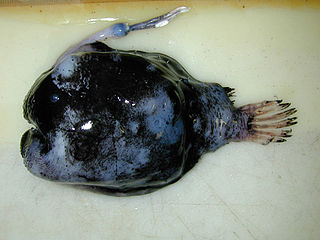
The footballfish form a family, Himantolophidae, of globose, deep-sea anglerfishes found in tropical and subtropical waters of the Atlantic, Indian, and Pacific Ocean. The family contains about 22 species all in a single genus, Himantolophus.
The brown topknot is a triplefin of the family Tripterygiidae, endemic to New Zealand in rock pools and from low water to depths of about 5 m, in reef areas of broken rock and large brown seaweed of genera Carpophyllum and Cystophora. Its length is up to about 8.5 cm.

Ostorhinchus compressus, commonly called the ochre-striped cardinalfish, blue-eyed cardinalfish or split banded cardinalfish, is a marine cardinalfish from the Indo-West Pacific from the family Apogonidae. It occasionally makes its way into the aquarium trade. It grows to a size of 12 cm in length.
Garra compressus is a species of ray-finned fish in the genus Garra which occurs only in Manipur in eastern India.

Potamogeton compressus is a species of aquatic plant known by the common names grass-wrack pondweed, flatstem pondweed and eel-grass pondweed.

Himantolophus groenlandicus, the Atlantic footballfish or Atlantic football-fish, is an anglerfish found primarily in mesopelagic depths of the ocean. Despite its name, this species might not be restricted to the Atlantic Ocean, with its range possibly extending into the Indian Ocean and to the Pacific Ocean. It is found in tropical and temperate regions.
Himantolophus albinares is a species of footballfish, a type of anglerfish. The fish is bathypelagic and can be found at depths ranging from 330 to 1,950 metres. It is endemic to the Atlantic Ocean. As of 1999, a total of four specimens had been found.
Himantolophus azurlucens is a species of footballfish, a type of anglerfish. The fish is bathypelagic and can be found at depths ranging from 900 to 1,100 metres. It is endemic to the eastern central Pacific Ocean and has been located off the coast of Panama.
Himantolophus borealis is a species of footballfish, a type of anglerfish. The fish is bathypelagic and can be found at depths below 1,210 metres (3,970 ft). It is endemic to the northwest Pacific Ocean.
Himantolophus brevirostris is a species of footballfish, a type of anglerfish. The fish is bathypelagic and can be found as deep as 3,000 metres (9,800 ft). It is endemic to the north Atlantic Ocean. So far, only males of the species have been found.
Himantolophus cornifer is a species of footballfish, a type of anglerfish. The fish is bathypelagic and can be found at depths ranging from 0 to 1,900 metres. It has been found in the Indian, Pacific, and Atlantic Oceans.
Himantolophus crinitus is a species of footballfish, a type of anglerfish. The fish is bathypelagic and has been found at depths of around 610 metres (2,000 ft). It is endemic to the eastern and southeastern central Atlantic Ocean. The species is currently only known from 11 specimens. Females attain a maximum size of 8.3 cm. While males have not yet been recorded, they are likely to be diminutive in comparison to the females, as is common in the family Himantolophidae.
Himantolophus litoceras is a species of footballfish, a type of anglerfish. The fish is bathydemersal and has been found at a depth of 654 metres (2,146 ft). It is endemic to the waters surrounding New Zealand.
Himantolophus macroceras is a species of footballfish, a type of anglerfish. The fish is bathypelagic and has been found as deep as 2,100 metres (6,900 ft). It is endemic to the east central Atlantic Ocean.
Himantolophus melanolophus is a species of footballfish, a type of anglerfish. The fish is bathypelagic and has been found at depths ranging from 360 to 880 metres. It is endemic to the west central Atlantic Ocean.
Himantolophus multifurcatus is a species of footballfish, a type of anglerfish. The fish is bathypelagic and has been found at depths ranging from 200 to 365 metres. It is endemic to the east central Atlantic Ocean.

Himantolophus paucifilosus is a species of marine fish of the family Himantolophidae, the footballfishes, a type of anglerfish. The fish is bathypelagic and has been found at depths ranging from 100 to 1,540 metres. It occurs in the east central Atlantic Ocean, from Cape Verde and Senegal in the north to Namibia and Angola in the south, and also on the coast of Brazil.
Himantolophus pseudalbinares is a species of footballfish, a type of anglerfish. The fish is bathypelagic and has been found as deep as 1,300 metres (4,300 ft). The species is endemic to the southeast Atlantic Ocean.
Himantolophus stewarti The Stewart'FootBall Fish is a species of footballfish, a type of anglerfish. The fish is bathydemersal and has been found at depths ranging from 400 to 1,413 metres. The species has mainly been found in the Tasman Sea, though it is likely to be endemic to the same areas as Himantolophus appelii.
Himantolophus rostratus is a species of footballfish, a type of anglerfish. The fish is both mesopelagic and bathypelagic and can be found in the Atlantic and Pacific Oceans.





